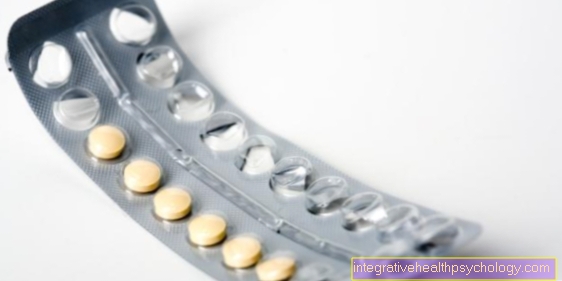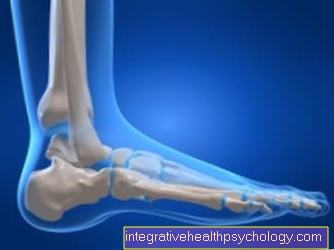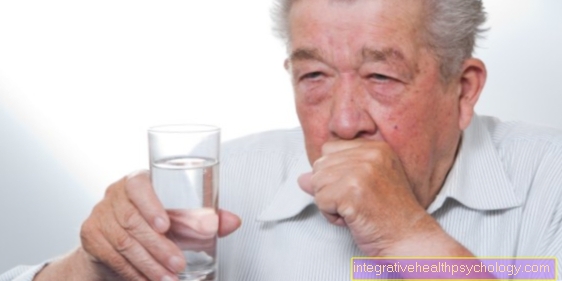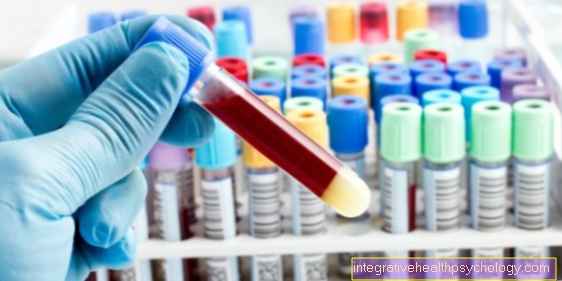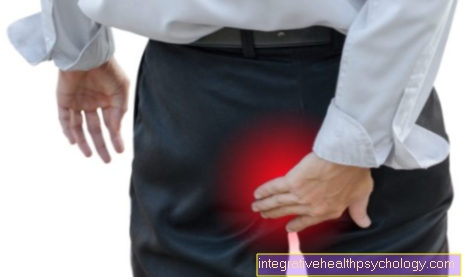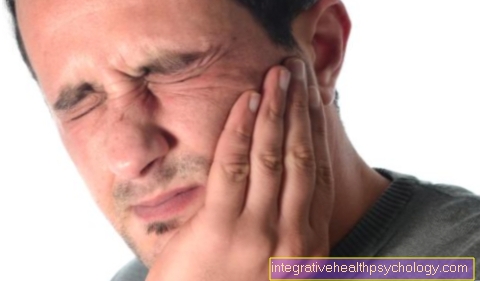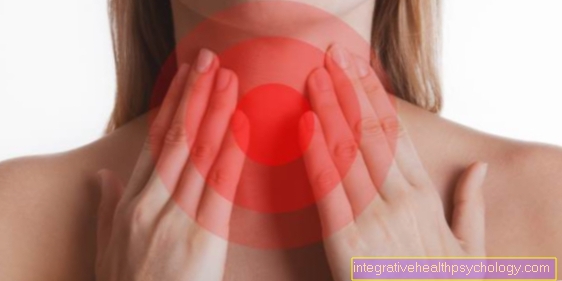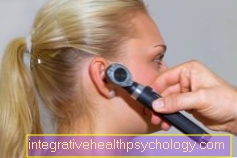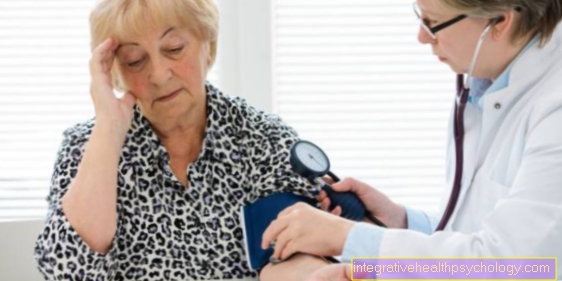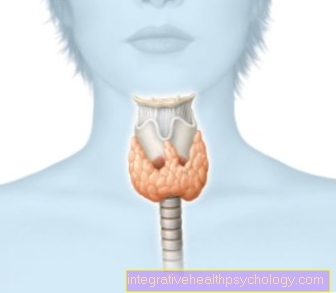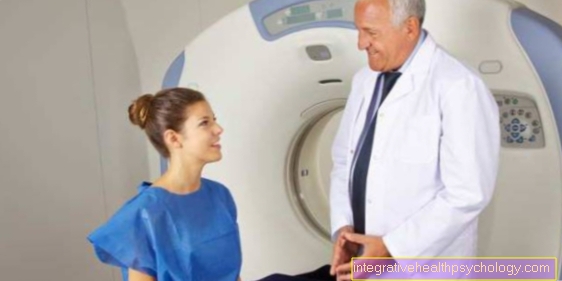Crohn's disease
Synonyms in a broader sense
Medical: regional enteritis, terminal ileitis
English: Crohn's disease, regional enteritis
Definition of Crohn's disease
The term Crohn's disease (Morbus = disease, Crohn = was the first person to describe this disease) is a chronic inflammatory bowel disease that can affect all parts of the gastrointestinal tract discontinuously (that means in sections). Most often, Crohn's disease occurs in the last section of the small intestine and first section of the colon.
Typical symptoms of Crohn's disease include diarrhea and abdominal pain.

Frequency / epidemiology
Occurrence in the population
Crohn's disease is seen around the world and from all ethnicities. More and more people get it every year. People between the ages of 15 and 35 are most commonly affected.
Crohn's disease
Crohn's disease can affect the entire digestive tract - from the gullet (esophagus) to the rectum.
However, the individual sections are affected differently often:
- Esophagus approx. 0.5%
- Stomach approx. 6%,
- Duodenum approx. 5%
- Small intestine (ileum) approx. 3%
- last loop of small intestine approx. 88%
- Large intestine (colon) approx. 70%
- Rectum approx. 20%.
The inflammation penetrates all layers of the walls of the digestive tract and usually comes in flares. The acute episode is characterized, among other things, by thickened intestinal walls.
The spread of the disease in the small and large intestines is mostly discontinuous (so-called "skip lesions"). Typically, a so-called paving stone relief of the intestinal mucosa can be seen endoscopically (e.g. during a colonoscopy).
Crohn's disease attack
Crohn's disease is a chronic disease that goes on in flares. This means, Phases of high disease activity and major complaints alternate Phases of low to no disease activity and accordingly low complaints.
The trigger flare-ups in Crohn's disease have not yet been clearly identified. What is clear, however, is that they can differ from patient to patient. One assumes that the interaction several factors triggers the thrust.
These factors can for example psychological stress, certain Food, Smoke, alcohol or be certain drugs.
In the course of their illness, many patients develop a feeling for which factors are decisive for them and thus learn to actively avoid relapses.
Unfortunately, this is not possible for all those affected, as the course of the disease is also genetically determined.
The Signs of thrust vary from patient to patient, some initially only notice a slight "grumble" in the stomach with slight diarrhea, while others develop massive diarrhea and abdominal pain from one day to the next.
What they all have in common, however, is an increasing worsening of the symptoms typical of the disease in a relatively short time.
At severe attacks it can too fever (Body temperature over 38.0 ° Celsius), which is a sign of severe inflammation in the body. Antipyretic drugs can remedy this in consultation with the attending physician.
About a third of all Crohn's disease patients suffer from joint problems in the form of pain or inflammation. Are in the push rather the large joints affected, for example the knee or elbow joints.
Outside of the attacks, they tend to do it smaller joints discomfort in the fingers or toes.
In general, if you suspect an approaching flare-up, a doctor should be consulted in order to contain the inflammation as quickly as possible and to avoid damage to the intestines or the rest of the body.
Please also read: Crohn's disease attack
Crohn's disease in children
Crohn's disease has its peak between 15 and 30 years of age, is therefore more of a disease of the younger generation and therefore often occurs in children.
The symptoms do not differ from those in adults, so the most common are diarrhea, abdominal pain, flatulence and a reduced general condition with a feeling of illness.
These symptoms must be by no means always together occur, but often occur alone.
In children, however, there is also the symptom of Growth retardation which can also be the only symptom of Crohn's disease.
To ensure a normal growth of the child is one rapid diagnosis and therapy so all the more important!
To therapy the same measures and drugs are used as in adults. In order to avoid long-term damage, doctors are even more careful than adults to dose the medication as low as possible but as high as necessary.
With the optimal drug setting, normal development with a very good quality of life can usually be achieved.
Causes of Crohn's Disease
The cause of Crohn's disease is not yet fully understood. Several factors are discussed:
- family disposition
- genetic causes
- infectious causes or
- immunological causes.
The improvement that occurs under corticoids (cortisone) speaks for an immunological, i.e. Originating from the body's defense system, as can be found in all rheumatic diseases.
Corticoids suppress the body's own defense system (immunosuppression). In some patients, an improvement can also be observed if certain foods are avoided. Allergies may play a role here.
Read more on the topic: Diagnosis of Crohn's disease
Complaints / symptoms
The symptoms of Crohn's disease depend on the different stages and manifestations. They are caused by the localization, extent and activity of the inflammatory process. The effects on neighboring organs can also play a role.
The disease progresses in phases and manifests itself mainly through abdominal pain, gas and diarrhea, which can rarely be bloody.
Nausea, vomiting, and fever are also common.
As a result, there is usually weight loss, especially during an episode, combined with a strong feeling of illness, tiredness and possibly a greatly reduced general condition.
Read more on the topic: Crohn's disease attack
In terms of symptoms, Crohn's disease can often not be clearly distinguished from ulcerative colitis. Appendicitis can also be confused with it.
In addition to the symptoms that relate directly to the intestine, there are also so-called. extraintestinal manifestations - So a symptom independent of the digestive tract.
This is why some patients develop joint inflammation and pain in the early stages, primarily in the large joints of the arms and legs, the spinal joints and the sacrum-iliac joint.
Often these complaints persist even when there are no relapses, but more often in the small joints of the fingers and toes.
Inflammation of the cornea or the iris of the eye (these are expressed as redness and pain), of the mouth (in the form of painful canker sores)
Rashes like this can appear on the skin Erythema nodosum or that Pyoderma gangrenosum, gallstones can form and liver changes can occur.
Read more about this under: Symptoms of Crohn's disease, pyoderma gangrenosum
Pain
Pain occurs in Crohn's disease especially during the episodes on, but also in about a fifth of those affected non-relapse time.
The most common are Abdominal pain in the right lower abdomen. The type of pain varies from patient to patient.
In addition, there is the pain caused by inflammation outside the intestine (see above).
Painkillers can help, but they should be taken only in consultation with the attending physician because some common and over-the-counter pain relievers can trigger or worsen flare-ups (for example Ibuprofen)!
Diarrhea / constipation
diarrhea represents that most common symptom of Crohn's disease.
Similar to pain, it can occur both during and outside of an attack.
The height Loss of fluid and nutrients can invalidate those affected within a very short time, which is why it is essential for a adequate hydration needs to be taken care of.
Due to the loss of nutrients, food should still be consumed. Easily digestible foods with little fat and little fiber are recommended here.
If the diarrhea persists, the stool should be treated with so-called antidiarrheal drugs (e.g. Loperamide) are thickened. Next to it are source substances such as Psyllium husks available, which develop a "water-drawing" effect in the intestine and thus thicken the stool.
Constipation can occur less frequently than diarrhea.Here, too, the consistency of the stool should be adjusted through the diet (fiber-rich diet, plenty of fluids); laxatives or swelling agents can be used as prescribed by a doctor.
Symptoms on the skin
The disease manifests itself on the skin primarily through inflammation of the subcutaneous fatty tissue, especially on the knees, lower legs and ankle joints.
These lead to the formation of several, reddish to greenish and extremely painful Nodules (so-called erythema nodosum).
Less often it can also become extremely painful, extensive Ulceration come with the following death of the affected skin (Pyoderma gangrenosum). These require rapid professional care in order to keep tissue damage as low as possible.
Symptoms in Children
Crohn's disease manifests itself in children through the same symptoms as in adults, i.e. primarily through stomach pain, diarrhea and Weight loss.
Often only a few of these complaints are found. It also occurs as a result of chronic inflammation in children Growth retardation up to complete growth behavior, which may be the only symptom of the disease.
A early diagnosis and treatment is therefore very important in children to ensure normal growth.
Mental symptoms
Affected people are at an increased risk depression to develop. One of the reasons for this is that symptoms such as severe diarrhea or constant pain Participation in social life complicate and too lonliness to lead.
Also, because of the reduced general condition, less sport is done and the patients generally feel less desire to be socially or physically active and therefore tend to withdraw more.
Depression or anxiety affect itself in turn unfavorable on the course the disease and can cause new attacks - a vicious circle that those affected should break out of with professional help if necessary.
Please also read: How can you recognize depression?
Blood in the stool
Blood in the stool, usually either mixed with the stool or “on top”, is less common in Crohn's disease than in ulcerative colitis.
The blood suggests an active inflammatory process in the intestine that injures the mucous membrane or even deeper layers of the intestinal wall.
If there is blood in the stool, a doctor should always be consulted in order to rule out other serious illnesses that can be revealed by blood in the stool.
Read more on the topic: Blood in the stool or Blood in the stool - these are the causes!
diagnosis

The most important are the Ultrasonic (Sonography) and the Colonoscopy (Colo- ileoscopy).
In the ultrasound one can see intestinal wall thickening, intestinal enlargements before the possible narrowing, as well as fistulas.
During a colonoscopy, the so-called cobblestone relief of the intestinal mucosa is noticeable. Complications such as fistulas (see explanation below), ulcers (mucosal ulcers) or stenoses (constrictions due to scarring) can also be visualized.
The Laboratory values the following results arise within the scope of the signs of inflammation:
- ESR - acceleration (sedimentation rate increased)
- Increase in CRP (C-reactive protein; inflammation parameters: the higher the value, the more severe the inflammation; however, it does not indicate the type of inflammation.)
- as well as an increased number of white blood cells and platelets (White blood cells and platelets).
Since the bowel function is disturbed in Crohn's disease, vital Vitamins and Trace elements are poorly absorbed.
The following constellations are conceivable:
- Vitamin B12 decreased
- Calcium humiliated
- Magnesium decreased
- Iron lowers
- Vitamin A and D decreased
To rule out intestinal inflammation caused by the pathogen, stool samples are also examined for germs.
Sometimes a MRT according to Sellink technology carried out. This is a MRI of the abdomen with contrast medium, which can make inflammatory changes in the intestinal mucosa visible.
therapy
Long-term therapy for Crohn's disease always begins in the Remission, i.e. when the patient is not in the push.
Long-term therapy with mesalazine (5-ASA) is desirable because it is effective and has few side effects. In some patients, that one drug is enough to control the disease.
If this is not the case, cortisone is also used in the lowest possible dose, locally (as an enema or enema) or systemically (as a tablet).
Alternatively, immunomodulators such as methotrexate (MTX) or azathioprine can also be used.
Unfortunately, the latter can be associated with severe side effects, which is why patients have to be re-examined frequently.
The relatively new TNF blockers (e.g. Humira®) have also had good experiences in long-term therapy.
In the case of severe complications such as constrictions, fistulas or abscesses, surgical removal of the affected bowel sections may be necessary.
You may also be interested in this article: Infliximab
Humira®
Humira® belongs to the relatively new group of TNF blockers. The active ingredient of the drug is called Adalimumab. Remicade® (Infliximab) is another well-known representative of this group of active ingredients.
As an antibody, it “intercepts” TNF that is circulating in the body. TNF, in turn, is a molecule that is secreted by inflamed cells to attract inflammatory cells of the immune system and stimulate them to multiply.
If it is eliminated by Humira®, the inflammation will be reduced. It is used in Crohn's disease when other drugs do not have the desired effect.
It needs to be injected directly into the bloodstream on a regular basis.
The side effects include unspecific reactions such as muscle pain, rashes and loss of appetite, as well as an increased risk of infection. Dormant tuberculosis can be reactivated by Humira®, which is why this should be ruled out before starting therapy.
You may also be interested in this article: Infliximab
Therapy of thrust
The type of treatment always depends on the severity of the attack.
In general, dietary measures are taken first to relieve the intestines and to remove any allergens from the body.
Please also read: Diet in Crohn's disease
In some cases, people switch to special liquid food or nutrition "via the vein" (parenteral nutrition) for the duration of the attack.
The first medicinal products used are mesalazine (5-ASA) and cortisone in local form, i.e. as enemas or enema (suppositories).
If the inflammation cannot be contained in this way, cortisone administered systemically, i.e. as a tablet or intravenously, must be used. If the therapy fails further, immunomodulators such as azathioprine or methotrexate are used.
Homeopathy for Crohn's Disease
Homeopathic remedies cannot cure Crohn's disease and are in no way intended to replace other medically prescribed drugs.
They may only be used as a supplement and only with the consent of the treating specialist. If these requirements are met, Arsenicum album, Sulfur or Phosphorus can be used against the symptoms of Crohn's disease, for example. Some Schüssler salts are said to have a soothing effect, for example salts number 24, 5 and 19.
Complications
The following complications can occur with Crohn's disease:
- mechanical intestinal obstruction (ileus):
Narrowing of the intestinal lumen (intestinal tube) is usually inflammatory in the initial stage, later fibrous (due to connective tissue adhesions). - Fistulas:
pathological connections e.g. E.g. between two intestinal loops (enteroenteric), between intestinal loops and the urinary bladder (enterovesikal) or the vagina (enterovaginal); Fistulas are the most common complication of Crohn's disease. - Blood discharges (blood in the stool can be recognized by its consistency and color: so-called tarry stool):
suggests involvement of the large intestine or rectum (rectum), as they are very rare when the small intestine is involved.
Read more on the topic: Blood in the stool - Perforation (the inflammation of the intestinal wall causes a breakthrough and both air and stool can enter the abdomen):
can be detected in the X-ray image through free air in the overview image of the abdomen (abdomen overview) - Malignancy risk:
The risk of cancer of the small intestine (small intestine) is significantly increased, while the risk of colon cancer is hardly increased.
For more information about fistulas in the genital area or in the intestine, read our articles:
Fistula in the genital area - everything you should know
Fistula in the intestine - causes & therapy
Diet in Crohn's disease
Diet naturally plays a major role in inflammatory bowel disease and can contribute to that to extend non-relapse periods and illness-related Minimize discomfort.
However, there are no fixed dietary recommendations for patients with Crohn's disease; every patient should try to find out which foods are good for them and which are not.
A Food diaryby documenting the type and time of eating as well as any subsequent complaints, can help to identify incompatible foods.
However, it's not just about the food itself, it's also about theirs preparation on. Forms of preparation such as steaming, stewing, simmering, lightly searing or boiling are often better tolerated than deep-frying, breading, roasting or deep searing in a lot of fat. But the same applies here: try, try, try!
prophylaxis
Unfortunately, there is no prophylaxis for Crohn's disease, as the cause (s) have not yet been sufficiently researched or not yet confirmed.
However, you should try to minimize the relapses by paying attention to your diet. Food that is poorly tolerated should therefore be avoided.
Smoking should also be avoided. You cannot avoid the attacks entirely.
You can only try to contain them once they occur.
forecast
A cure of Crohn's disease is to this day not possible. An attempt is made to bring the attacks under control with medication.
The Life expectancy is generally hardly or not at all restricted in patients with optimally treated Crohn's disease. However, it has been proven that Crohn's disease patients have a significantly higher risk than the normal healthy population Small bowel cancer to get sick, so should regular checks in the sense of a Colon cancer screening respectively.
Is there a cure?
Crohn's disease is one chronic disease, a cure is not possible according to the current state of science.
Since the disease can affect the entire digestive tract from mouth to rectum, it is, as opposed to Ulcerative colitiswhich only affects the colon, it is not possible to simply remove the affected organ.
Drug therapy, too, only aims to dampen the inflammation in the body and thus the disease activity.
There is no causal therapy, also because the exact cause of Crohn's disease has not yet been identified.
Nevertheless, under specialist therapy with the current medication, in most patients a largely normal quality of life can be achieved.
More about Crohn's disease
- These are the causes of Crohn's disease
- The typical symptoms of Crohn's disease
- This is how Crohn's disease is treated
- Proper nutrition for Crohn's disease
- Is Crohn's disease curable?
- What is life expectancy in Crohn's disease
- Chron disease - relapse
- This is how the doctor diagnoses Crohn's disease
- Chron disease and alcohol consumption, is that possible?

